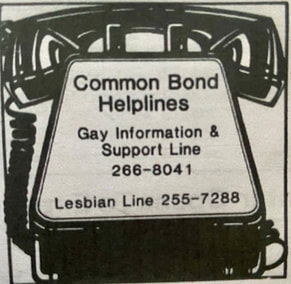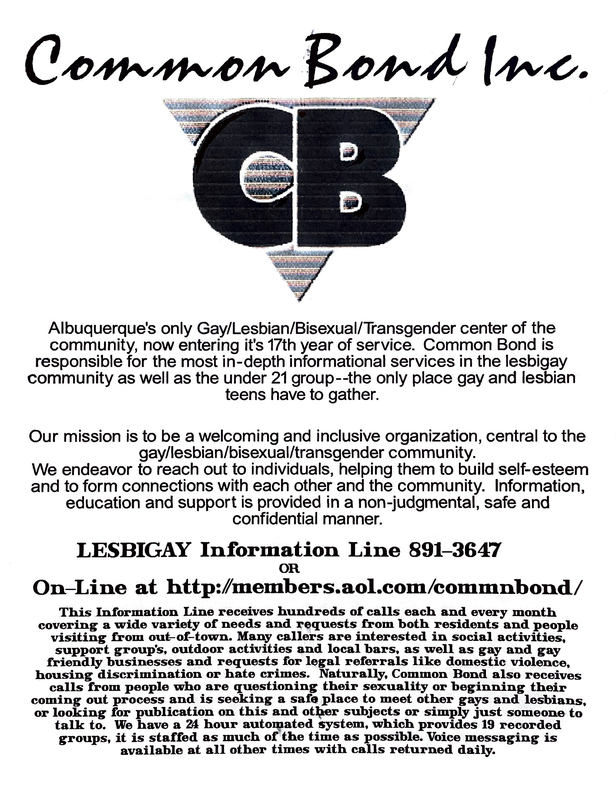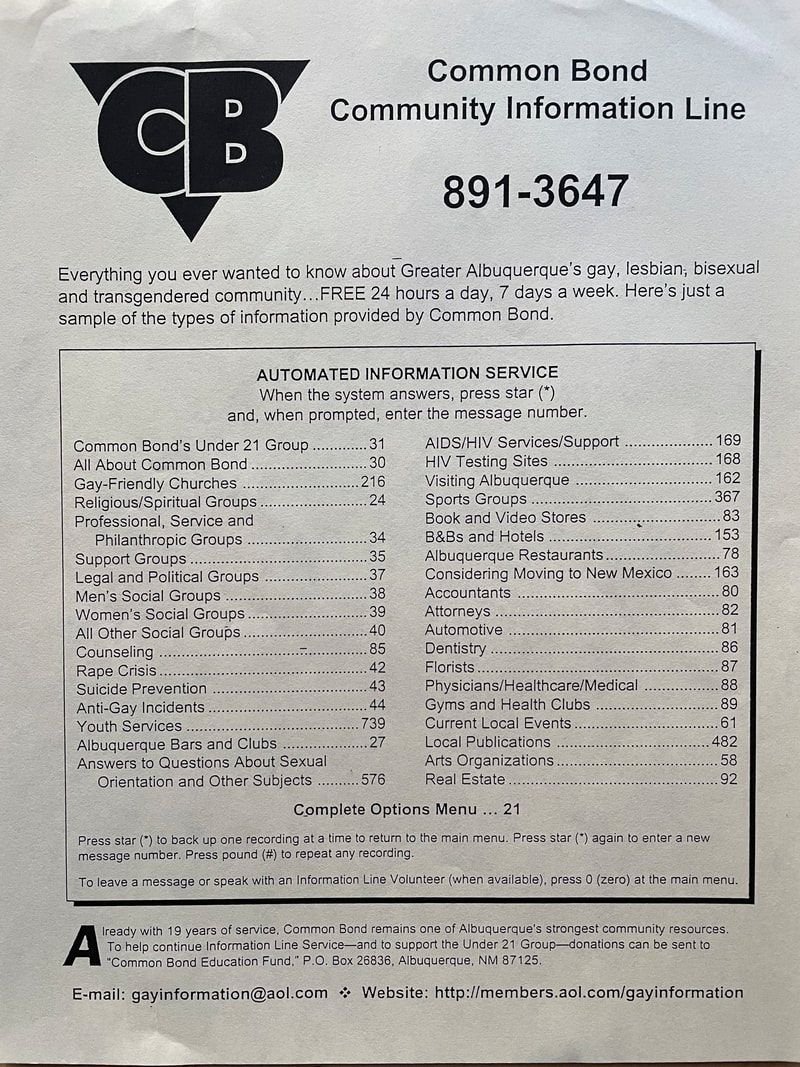28 Years of Helplines and Information Phone Service
Common Bond was founded to nurture Albuquerque’s growing LGBTQ+ community, providing information and events to foster pride and momentum for expanding our civil rights. A monthly printed newsletter was central to those efforts, but adding a public phone number expanded our outreach throughout the state of New Mexico and even to other parts of the country.
On February 8, 1982, the Common Bond Communications Committee held its first meeting. Then, this blurb appeared in the March 1982 issue of the Common Bond Ink newsletter:
266-4061. Got it? 266-4041. Ring, ring. “Hello, Gay Information and Referral Service. How can we help you?” You got it! Common Bond’s
telephone information directory and referral service now has one of its key elements, a telephone. The service is not fully operational, but
Common Bond will start handling calls right away, even as information and reference resources are gathered. If you know a business,
activity, event or helping service which ought to be listed in the directory, or if you want to help with this project, call the Referral Service,
or write Common Bond, P.O. Box 1191, Albuquerque, NM 87103. The best time to reach a live gay person is Monday through Thursday
evenings, 7-10 p.m. At other times you will be answered by a polite and friendly gay answering machine which will record your message.
Even before Common Bond had a physical meeting place for the community, Common Bond volunteers were jumpstarting with phone assistance. Sometimes referred to as the Information and Support Line (or simply the Helpline), it was an all-encompassing service. It provided a contact point for lesbian and gay people who were new to the Albuquerque area, coming out, or simply wanting someone to talk to about their personal issues. In its earliest months, the landline and an answering machine were installed in the home of Common Bond board member Brian Lanter. Volunteers came over in the evening to answer calls from his dining room.
On February 8, 1982, the Common Bond Communications Committee held its first meeting. Then, this blurb appeared in the March 1982 issue of the Common Bond Ink newsletter:
266-4061. Got it? 266-4041. Ring, ring. “Hello, Gay Information and Referral Service. How can we help you?” You got it! Common Bond’s
telephone information directory and referral service now has one of its key elements, a telephone. The service is not fully operational, but
Common Bond will start handling calls right away, even as information and reference resources are gathered. If you know a business,
activity, event or helping service which ought to be listed in the directory, or if you want to help with this project, call the Referral Service,
or write Common Bond, P.O. Box 1191, Albuquerque, NM 87103. The best time to reach a live gay person is Monday through Thursday
evenings, 7-10 p.m. At other times you will be answered by a polite and friendly gay answering machine which will record your message.
Even before Common Bond had a physical meeting place for the community, Common Bond volunteers were jumpstarting with phone assistance. Sometimes referred to as the Information and Support Line (or simply the Helpline), it was an all-encompassing service. It provided a contact point for lesbian and gay people who were new to the Albuquerque area, coming out, or simply wanting someone to talk to about their personal issues. In its earliest months, the landline and an answering machine were installed in the home of Common Bond board member Brian Lanter. Volunteers came over in the evening to answer calls from his dining room.
|
In March 1984, the Helpline moved to Common Bond’s new office space on San Pedro Drive NE. John Fellin joined the board of directors in September 1984. At that time, he was already in charge of the Helpline, the Common Bond library, and office scheduling. In May 1985, he announced a day-long volunteer education workshop to provide new volunteers with an orientation to Common Bond -- and for current and former volunteers to reactivate their commitment. Over the previous eight months, the Helpline had received 1,596 calls.
|
Many of the Helpline calls were requests for information – questions about events, organizations, gay businesses, bars, referrals to lesbian and gay professionals, and sexual health. Callers could also place and check on roommate listings. Common Bond also would refer callers interested in writing possible pen pals in care of Common Bond. Volunteers made every effort to locate someone who could answer specific questions. This “clearinghouse” function kept accurate information flowing throughout the community.
Fellin stated in Common Bond Ink, “The Information Line is one of the best ways in which Common Bond can provide information to the city at large and help build the sense of community that is one of the goals of Common Bond.”
However, one of its most important functions was taking reports of discrimination and violence against gays and lesbians and forwarding them to appropriate agencies. This was all taking place while Common Bond was still operating out of its first one-room office on San Pedro Drive NE.
By August 1986, the Helpline was receiving an average of 284 calls a month. Because the Common Bond phone number was now listed in the national GAYELLOW PAGES, as well as in the local Business White Pages under both “Gay” and “Lesbian”, many calls were from people visiting Albuquerque for the first time or moving here. Quite often, Helpline volunteers found themselves acting as a sort of “Gay Welcome Wagon” to newcomers.
While Helpline volunteers were not trained counselors, they were “active listeners” who encouraged callers to speak as freely as possible, letting them work out their own solutions to their problems. Whether the caller was struggling with health issues, relationship problems, or just tackling the challenges of coming out, the volunteer’s basic approach was the same – to help the caller work out his or her best solution. Whenever difficult problems arose, the Helpline provided resources such as peer support, a rap group, or professional counseling. Confidentiality was maintained always.
In 1986, Helpline Coordinator Garland Harris, assisted by Ron Gaudreau, headed a steering committee which shaped updated policies and goals of the information line. Monthly meetings for more than 15 volunteers gave them a chance to speak about concerns they might have, as well as providing opportunities for receiving and exchanging information about how to better handle various situations. Role playing and guest speakers provided ways to test new approaching for handling calls.
Fellin stated in Common Bond Ink, “The Information Line is one of the best ways in which Common Bond can provide information to the city at large and help build the sense of community that is one of the goals of Common Bond.”
However, one of its most important functions was taking reports of discrimination and violence against gays and lesbians and forwarding them to appropriate agencies. This was all taking place while Common Bond was still operating out of its first one-room office on San Pedro Drive NE.
By August 1986, the Helpline was receiving an average of 284 calls a month. Because the Common Bond phone number was now listed in the national GAYELLOW PAGES, as well as in the local Business White Pages under both “Gay” and “Lesbian”, many calls were from people visiting Albuquerque for the first time or moving here. Quite often, Helpline volunteers found themselves acting as a sort of “Gay Welcome Wagon” to newcomers.
While Helpline volunteers were not trained counselors, they were “active listeners” who encouraged callers to speak as freely as possible, letting them work out their own solutions to their problems. Whether the caller was struggling with health issues, relationship problems, or just tackling the challenges of coming out, the volunteer’s basic approach was the same – to help the caller work out his or her best solution. Whenever difficult problems arose, the Helpline provided resources such as peer support, a rap group, or professional counseling. Confidentiality was maintained always.
In 1986, Helpline Coordinator Garland Harris, assisted by Ron Gaudreau, headed a steering committee which shaped updated policies and goals of the information line. Monthly meetings for more than 15 volunteers gave them a chance to speak about concerns they might have, as well as providing opportunities for receiving and exchanging information about how to better handle various situations. Role playing and guest speakers provided ways to test new approaching for handling calls.
|
In August 1986, Common Bond launched its Lesbian Helpline, which at that time may have been the only telephone line of its kind in the country, according to Garland Harris, the head of the new project. A new dedicated phone number offered callers the latest information about the lesbian community in New Mexico.
The phone line, staffed every evening between 7 and 10 p.m., also provided peer counselling. The Lesbian Helpline served as a major communication link for the extensive informal network of women’s groups and organizations already in existence in New Mexico. Harris said, “Although the lesbian community in Albuquerque is well organized, it is difficult for newcomers to plug into it. Full Circle Books serves as an excellent clearinghouse for lesbian events, but we need a more readily identifiable communications network and one that is available during the evenings.” Indeed, the Lesbian Helpline received 25 calls in its first week, with the number increasing each following week. |
The Lesbian Helpline and the Common Bond Helpline were both housed in the new Common Bond Community Center which had just opened on Tulane Drive SE. Between November 1, 1986 and July 31, 1987, the Gay Helpline had received over 2,200 calls and the Lesbian Helpline had received over 1,300 calls.
In November 1987, Ron Gaudreau, chair of the Common Bond Helpline Committee, and Alan Stringer, president of Common Bond, met with representatives from Albuquerque Public Schools’ Student Services Department, Stringer and Gaudreau were working with the public schools to develop an informational network with the counseling offices in all of Albuquerque’s high schools. The APS Student Services Department agreed that it would be beneficial for their counseling offices to have information available to refer lesbian and gay students to Common Bond’s HelpLine and Common Bond’s weekly youth group.
In November 1987, Ron Gaudreau, chair of the Common Bond Helpline Committee, and Alan Stringer, president of Common Bond, met with representatives from Albuquerque Public Schools’ Student Services Department, Stringer and Gaudreau were working with the public schools to develop an informational network with the counseling offices in all of Albuquerque’s high schools. The APS Student Services Department agreed that it would be beneficial for their counseling offices to have information available to refer lesbian and gay students to Common Bond’s HelpLine and Common Bond’s weekly youth group.
|
In 1991, previous Common Bond president Karl Nowosel created a computerized back-up system for the Helpline so that callers could receive timely information 24/7. This consisted of nearly 900 recorded scripts stored on computers in his Rio Rancho home. Prompts led after-hours callers to the type of information they were seeking. Because he enjoyed providing this service so much, Nowosel programmed the system so that on evenings and weekends when he was home, if a caller pressed “0”, he was alerted and could pick up the call.
Common Bond’s Helpline (now called the Community Information Line) was 15 years old when the Silver Avenue Community Center closed in October 1997. At that time, it was averaging 65 calls per month. Personal response service continued for another two months under volunteer coordinator Don Stevens. Voicemail messages were retrieved at least twice a day and volunteers called back with as much information and assistance as possible. Thereafter, Karl Nowosel kept the computer-assisted Common Bond Information Line operating into 2010, personally paying for the telephone line, photocopying information and mailing it to people seeking it. |


